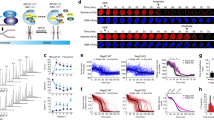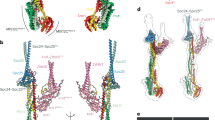Abstract
Faithful chromosome segregation is essential for maintaining the genomic integrity, which requires coordination among chromosomes, kinetochores, centrosomes and spindles during mitosis. Previously, we discovered a novel coiled-coil protein, highly expressed in cancer 1 (Hec1), which is indispensable for this process. However, the precise underlying mechanism remains unclear. Here, we show that Hec1 directly interacts with human ZW10 interacting protein (Zwint-1), a binding partner of Zeste White 10 (ZW10) that is required for chromosome motility and spindle checkpoint control. In mitotic cells, Hec1 transiently forms complexes with Zwint-1 and ZW10 in a temporal and spatial manner. Although the three proteins have variable cell cycle-dependent expression profiles, they can only be co-immunoprecipitated during M phase. Immunofluorescent study showed that Hec1 and Zwint-1 co-localize at kinetochores beginning at prophase and that ZW10 joins them later at prometaphase. Depletion of Hec1 impairs the recruitment of both Zwint-1 and ZW10 to kinetochores, while depletion of Zwint-1 abrogates the kinetochore localization of ZW10 but not Hec1. The results suggest that the localization of Hec1 at kinetochores is required for the sequential recruitment of Zwint-1 and ZW10. Disrupting this recruitment by inhibiting the expression of Hec1 or Zwint-1 causes chromosome missegregation, spindle checkpoint failure, and eventually cell death upon cytokinesis. Taken together, these results, at least in part, provide a molecular basis to explain how Hec1 plays a crucial role for spindle checkpoint control and faithful chromosome segregation.
This is a preview of subscription content, access via your institution
Access options
Subscribe to this journal
Receive 50 print issues and online access
$259.00 per year
only $5.18 per issue
Buy this article
- Purchase on Springer Link
- Instant access to full article PDF
Prices may be subject to local taxes which are calculated during checkout








Similar content being viewed by others
Abbreviations
- Hec1:
-
highly expressed in cancer 1
- Zwint-1:
-
human ZW10 interacting protein
- ZW10:
-
Zeste White 10
- CIN:
-
Chromosome instability
- M phase:
-
mitotic phase
- Rb:
-
retinoblastoma protein
- MT:
-
microtubule
- kMT:
-
kinetochore microtubule
- RNAi:
-
RNA interference
- siRNA:
-
Short interfering RNA
- Sc :
-
Saccharomyces cerevisiae
- GFP:
-
Green fluorescent protein
- GST:
-
glutathione S-tansferase
References
Amon A . (1999). Curr Opin Genet Dev 9: 69–75.
Basto R, Gomes R, Karess RE . (2000). Nat Cell Biol 2: 939–943.
Bharadwaj R, Qi W, Yu H . (2004). J Biol Chem 279: 13076–13085.
Biggins S, Murray AW . (2001). Genes Dev 15: 3118–3129.
Brinkley BR, Stubblefield E . (1966). Chromosoma 19: 28–43.
Chan GK, Jablonski SA, Starr DA, Goldberg ML, Yen TJ . (2000). Nat Cell Biol 2: 944–947.
Chan GK, Jablonski SA, Sudakin V, Hittle JC, Yen TJ . (1999). J Cell Biol 146: 941–954.
Chan GK, Liu ST, Yen TJ . (2005). Trends Cell Biol 15: 589–598.
Cheeseman IM, Anderson S, Jwa M, Green EM, Kang J, Yates III JR et al. (2002a). Cell 111: 163–172.
Cheeseman IM, Drubin DG, Barnes G . (2002b). J Cell Biol 157: 199–203.
Chen PL, Scully P, Shew JY, Wang JY, Lee WH . (1989). Cell 58: 1193–1198.
Chen Y, Riley DJ, Chen PL, Lee WH . (1997a). Mol Cell Biol 17: 6049–6056.
Chen Y, Riley DJ, Zheng L, Chen PL, Lee WH . (2002). J Biol Chem 277: 49408–49416.
Chen Y, Sharp ZD, Lee WH . (1997b). J Biol Chem 272: 24081–24087.
Ciferri C, De Luca J, Monzani S, Ferrari KJ, Ristic D, Wyman C et al. (2005). J Biol Chem 280: 29088–29095.
Cleveland DW, Mao Y, Sullivan KF . (2003). Cell 112: 407–421.
Craig JM, Earnshaw WC, Vagnarelli P . (1999). Exp Cell Res 246: 249–262.
De Wulf P, McAinsh AD, Sorger PK . (2003). Genes Dev 17: 2902–2921.
Deluca JG, Dong Y, Hergert P, Strauss J, Hickey JM, Salmon ED et al. (2005). Mol Biol Cell 16: 519–531.
Desai A, Rybina S, Muller-Reichert T, Shevchenko A, Hyman A, Oegema K . (2003). Genes Dev 17: 2421–2435.
Dobles M, Liberal V, Scott ML, Benezra R, Sorger PK . (2000). Cell 101: 635–645.
Earnshaw WC, Rothfield N . (1985). Chromosoma 91: 313–321.
Earnshaw WC, Sullivan KF, Machlin PS, Cooke CA, Kaiser DA, Pollard TD et al. (1987). J Cell Biol 104: 817–829.
Elbashir SM, Harborth J, Lendeckel W, Yalcin A, Weber K, Tuschl T . (2001). Nature 411: 494–498.
Emanuele MJ, McCleland ML, Satinover DL, Stukenberg PT . (2005). Mol Biol Cell 16: 4882–4892.
Fang G, Yu H, Kirschner MW . (1998). Genes Dev 12: 1871–1883.
Fodde R, Kuipers J, Rosenberg C, Smits R, Kielman M, Gaspar C et al. (2001). Nat Cell Biol 3: 433–438.
He X, Rines DR, Espelin CW, Sorger PK . (2001). Cell 106: 195–206.
Hori T, Haraguchi T, Hiraoka Y, Kimura H, Fukagawa T . (2003). J Cell Sci 116: 3347–3362.
Hoyt MA, Totis L, Roberts BT . (1991). Cell 66: 507–517.
Hsu JY, Sun ZW, Li X, Reuben M, Tatchell K, Bishop DK et al. (2000). Cell 102: 279–291.
Janke C, Ortiz J, Lechner J, Shevchenko A, Magiera MM, Schramm C et al. (2001). EMBO J 20: 777–791.
Kanda T, Sullivan KF, Wahl GM . (1998). Curr Biol 8: 377–385.
Kaplan KB, Burds AA, Swedlow JR, Bekir SS, Sorger PK, Nathke IS . (2001). Nat Cell Biol 3: 429–432.
Kitagawa K, Hieter P . (2001). Nat Rev Mol Cell Biol 2: 678–687.
Kniola B, O'Toole E, McIntosh JR, Mellone B, Allshire R, Mengarelli S et al. (2001). Mol Biol Cell 12: 2767–2775.
Kops GJ, Kim Y, Weaver BA, Mao Y, McLeod I, Yates III JR et al. (2005). J Cell Biol 169: 49–60.
Lengauer C, Kinzler KW, Vogelstein B . (1997). Nature 386: 623–627.
Li R, Murray AW . (1991). Cell 66: 519–531.
Li X, Nicklas RB . (1995). Nature 373: 630–632.
Lou Y, Yao J, Zereshki A, Dou Z, Ahmed K, Wang H et al. (2004). J Biol Chem 279: 20049–20057.
Martin-Lluesma S, Stucke VM, Nigg EA . (2002). Science 297: 2267–2270.
McCleland ML, Gardner RD, Kallio MJ, Daum JR, Gorbsky GJ, Burke DJ et al. (2003). Genes Dev 17: 101–114.
McCleland ML, Kallio MJ, Barrett-Wilt GA, Kestner CA, Shabanowitz J, Hunt DF et al. (2004). Curr Biol 14: 131–137.
McEwen BF, Hsieh CE, Mattheyses AL, Rieder CL . (1998). Chromosoma 107: 366–375.
Meraldi P, Draviam VM, Sorger PK . (2004). Dev Cell 7: 45–60.
Michel LS, Liberal V, Chatterjee A, Kirchwegger R, Pasche B, Gerald W et al. (2001). Nature 409: 355–359.
Mikami Y, Hori T, Kimura H, Fukagawa T . (2005). Mol Cell Biol 25: 1958–1970.
Nigg EA . (2001). Nat Rev Mol Cell Biol 2: 21–32.
Obuse C, Iwasaki O, Kiyomitsu T, Goshima G, Toyoda Y, Yanagida M . (2004). Nat Cell Biol 6: 1135–1141.
Palmer DK, O'Day K, Wener MH, Andrews BS, Margolis RL . (1987). J Cell Biol 104: 805–815.
Rieder CL, Cole RW, Khodjakov A, Sluder G . (1995). J Cell Biol 130: 941–948.
Savoian MS, Goldberg ML, Rieder CL . (2000). Nat Cell Biol 2: 948–952.
Sharp DJ, Rogers GC, Scholey JM . (2000). Nat Cell Biol 2: 922–930.
Starr DA, Saffery R, Li Z, Simpson AE, Choo KH, Yen TJ et al. (2000). J Cell Sci 113: 1939–1950.
Starr DA, Williams BC, Hays TS, Goldberg ML . (1998). J Cell Biol 142: 763–774.
Starr DA, Williams BC, Li Z, Etemad-Moghadam B, Dawe RK, Goldberg ML . (1997). J Cell Biol 138: 1289–1301.
Takahashi T, Haruki N, Nomoto S, Masuda A, Saji S, Osada H . (1999). Oncogene 18: 4295–4300.
Tanaka TU, Rachidi N, Janke C, Pereira G, Galova M, Schiebel E et al. (2002). Cell 108: 317–329.
Tang Z, Bharadwaj R, Li B, Yu H . (2001). Dev Cell 1: 227–237.
Wang H, Hu X, Ding X, Dou Z, Yang Z, Shaw AW et al. (2004). J Biol Chem 279: 54590–54598.
Wei RR, Sorger PK, Harrison SC . (2005). Proc Natl Acad Sci USA 102: 5363–5367.
Wei Y, Yu L, Bowen J, Gorovsky MA, Allis CD . (1999). Cell 97: 99–109.
Weiss E, Winey M . (1996). J Cell Biol 132: 111–123.
Wigge PA, Jensen ON, Holmes S, Soues S, Mann M, Kilmartin JV . (1998). J Cell Biol 141: 967–977.
Wigge PA, Kilmartin JV . (2001). J Cell Biol 152: 349–360.
Williams BC, Goldberg ML . (1994). J Cell Sci 107: 785–798.
Williams BC, Karr TL, Montgomery JM, Goldberg ML . (1992). J Cell Biol 118: 759–773.
Williams BC, Li Z, Liu S, Williams EV, Leung G, Yen TJ et al. (2003). Mol Biol Cell 14: 1379–1391.
Xiao J, Liu CC, Chen PL, Lee WH . (2001). J Biol Chem 276: 6105–6111.
Zheng L, Chen Y, Lee WH . (1999). Mol Cell Biol 19: 5417–5428.
Zhou H, Kuang J, Zhong L, Kuo WL, Gray JW, Sahin A et al. (1998). Nat Genet 20: 189–193.
Zinkowski RP, Meyne J, Brinkley BR . (1991). J Cell Biol 113: 1091–1110.
Acknowledgements
We thank Dr Michael Goldberg for the human ZW10 cDNA plasmid, Dr Phang-Lang Chen and Bingnan Gu for technical support, Dr Daniel J Riley, Ms Saori Furuta and Lily Khidr for critically reading the manuscript. This work was supported by a grant from NIH (CA 107568) to WHL.
Author information
Authors and Affiliations
Corresponding author
Rights and permissions
About this article
Cite this article
Lin, YT., Chen, Y., Wu, G. et al. Hec1 sequentially recruits Zwint-1 and ZW10 to kinetochores for faithful chromosome segregation and spindle checkpoint control. Oncogene 25, 6901–6914 (2006). https://doi.org/10.1038/sj.onc.1209687
Received:
Revised:
Accepted:
Published:
Issue Date:
DOI: https://doi.org/10.1038/sj.onc.1209687
Keywords
This article is cited by
-
Novel small molecules disrupting Hec1/Nek2 interaction ablate tumor progression by triggering Nek2 degradation through a death-trap mechanism
Oncogene (2015)
-
Zwint-1 is required for spindle assembly checkpoint function and kinetochore-microtubule attachment during oocyte meiosis
Scientific Reports (2015)
-
Topoisomerase IIα in chromosome instability and personalized cancer therapy
Oncogene (2015)
-
KNL1: bringing order to the kinetochore
Chromosoma (2014)
-
Beclin‐1 is required for chromosome congression and proper outer kinetochore assembly
EMBO reports (2013)



